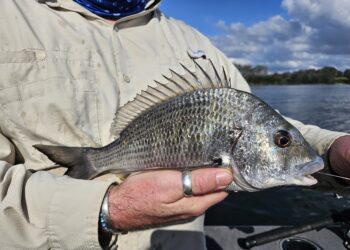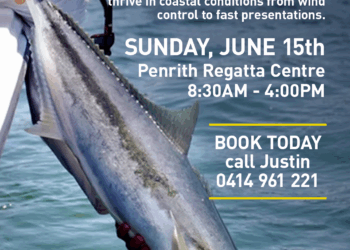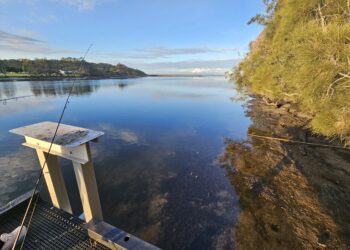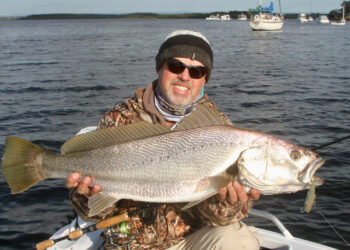BREAM are a ubiquitous species found all around Australia in lakes, rivers, estuaries, beaches and coastal surrounds. As an angling target they are an exceptional species being not only readily accessibly but attack all manner of baits and lures with gusto. This breadth of distribution and array of techniques to chase them gives rise to a number of rigging options. The optimal rig when fishing for bream will ultimately depend on a number of variables including the location and structure you are fishing, prevailing depth and current along with the size and type of bait or lure to name a few.

Rock and Beach rigs
Coastal rocks and beaches are often turbulent environments where longer rods come to the fore to assist with casting distance and line control. Rods tend to range in size from eight to twelve feet and capable of handling 6-10 kg line.
A running sinker rig is a classic in the surf however the standard running sinker can pose challenges with bulky baits cast over long distances. If using bulkier baits in the surf, an additional swivel above the sinker will restrict the sinker from running up the line. A paternoster rig with a star sinker can be a great rig option when fishing a gutter featuring a strong sweep of current. Bream can be found lurking in close to the rocks, around potholes and undulating reef or foraging the wash zone covered by white water. These areas often have treacherous bottoms resulting in plenty of snags for the uninitiated.
These lures come to the fore when cast adjacent to structure or over a shallow sand flat and worked with a slow retrieve.
An ideal rig for fishing the ocean rocks is a small ball sinker running straight to the hook with the sinker as light as possible. The technique to fishing this rig is to cast out, let it sink towards the bottom and keep it constantly moving to avoid your rig handing up in the reef. An alternate rig is to use a running float with the depth set to allow the bait to hover above the bottom. Float fishing with small bobby corks used to be a popular and effective technique which seems to have been forgotten about in recent times.
Estuary rigs
Bream are a common target in many estuary systems and one of the most popular bait and lures species chased by anglers of all ages. An estuary bream outfit is typically on the lighter side with rods from six to ten feet long and capable of fishing four to six kilo line the most versatile. A light running sinker rig is the simplest and most effective option in the estuaries.
This comprises a small ball sinker running on the main line, 30-60cm of trace and a size 1 to 1/0 chemically sharpened bait holder hook. An interesting rig in the estuaries involves the use of a berley cage. These usually replace the sinker and allow you to pack them full of mashed prawns, bread or whatever berley concoction you can think of.
Bream respond well to berley and a berley cage is a good old school technique to disperse a few tasty morsels right next to your bait. Whilst light lines are sinkers are usually best, a contrarian view is big sinkers and heavier main lines that allow you to pelt a bait out as far as possible to reach deeper water.
This is a particularly effective technique during the middle of the day and whilst not the most sporting of options, do yourself a favour and peek inside the bucket of someone pelting baits out in to the deep you will probably be surprised by the quality and quantity of bream they have caught.

Lure fishing rigs
Hard bodied lures and soft plastic lures offer a popular and exceptionally sporting way to actively target bream. The outfits used are typically light single handed casting rods often measuring about seven feet and coupled with 1000-2000 sized reels load with four to eight pound braided line.
A metre and a half of six to ten pound leader is connected directly to the braid using knots such as a double uni, slim beauty or improved Albright. There is a vast array of lures that you can catch bream on from hard body minnow lures to top water poppers and stick baits, metal blades and soft plastics to name a few.
The most versatile and easiest lure would have to be a small hardbody minnow. These lures come to the fore when cast adjacent to structure or over a shallow sand flat and worked with a slow retrieve featuring the occasional pause and twitch. Top water lures can offer exhilarating visual action and are best suited to the summer months when cicadas and prawns are active with late afternoon an ideal time for topwater luring. During the day when bream tend to retreat to the safety of deeper water, lures that sink readily like blades or heavily weighted soft plastics are ideally suited.
Soft plastics more generally are an exceptionally productive lure with lures between one to two and a half inches in size ideal for bream. Choose a jig head with a hook that matches the lure profile and weight to suit the conditions with 1/8 to 1/12 of an ounce a good starting range. The most important thing to remember when rigging soft plastics for bream is to ensure they are rigged perfectly straight. If the plastic is bent or kinked on the jig head, it will spin unnaturally when moving through the water and your catch rate will decrease dramatically!


















